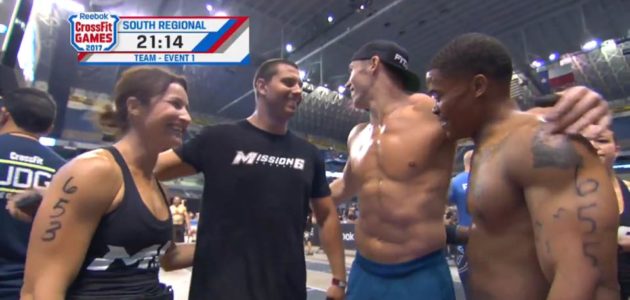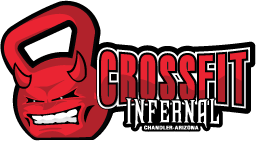 Being into fitness and sports my whole life has given me an extremely broad range of different training modalities and programming. At first, I really didn’t see it as any benefit, because typically moving from one style to another you tend to forget a lot of what you used to do. Plus, back when I started doing CrossFit training, it seemed to have this stigma that ANYTHING other than CrossFit was bogus and should never be talked about, seen, or done. You remember, (and it still happens) bench press was UNHEARD of in a CrossFit gym, and if you asked when it would be programmed you’d get a dirty glare and hear “that’s not functional, you don’t need to do that”.
Being into fitness and sports my whole life has given me an extremely broad range of different training modalities and programming. At first, I really didn’t see it as any benefit, because typically moving from one style to another you tend to forget a lot of what you used to do. Plus, back when I started doing CrossFit training, it seemed to have this stigma that ANYTHING other than CrossFit was bogus and should never be talked about, seen, or done. You remember, (and it still happens) bench press was UNHEARD of in a CrossFit gym, and if you asked when it would be programmed you’d get a dirty glare and hear “that’s not functional, you don’t need to do that”.
I couldn’t have agreed LESS, so I made a promise that if I ever had the opportunity to change people’s lives through fitness, I was going to bridge that gap and not see any type of movement as negative. As long as it’s done properly……
Fast forward almost 3 years – CrossFit has changed SO MUCH it’s becoming more difficult than ever to keep up with Mr. Dave Castro’s crazy mind. A fitness modality that was once pretty basic, has now exploded into a full-fledged sport, where the athletes are in (what seems sometimes) un-human shape, with movements that are more technical than ever. Not to mention the fatigued state you are in when asked to perform these modalities.
My goal here is to give you the basics behind a solid CrossFit program to ensure your people are getting the best of all worlds. Whether they are looking to be more competitive, looking for health and wellness, or just simply like to challenge themselves every day.
Let’s get back to the basics of CrossFit. The definition of CrossFit is, “Functional movements, performed at high intensities, that are constantly varied”.
Let’s break this apart really quick:
“Functional movements” means multi-joint movements, aka you’re moving multiple limbs at once, or in a sequence, to create maximum speed/power/strength. So, your squats, deadlifts, box jumps, burpees, etc., in comparison to “static movements,” standing in place using only a single joint. So, standing there doing a bicep curl (only using elbow joint) or a seated leg extension (only using knee joint). Got it?
“High intensity” can be simply broken down in 2 ways:
1.) The typical fashion of intensity. Bursts where you are exerting maximal output for a shorter time frame. This could be done in a strength component (3 rep back squat), or in a CrossFit WOD (5 min AMRAP of deadlifts and burpees). Your ability to maintain a higher output in a 5-minute workout is greater than in a 20-minute workout. Your rep counts will be lower, but the intensity is measured by your work, divided by the time.
2.) Longer duration workouts where a 20-minute AMRAP can be seen as “intense” purely based off the amount of work done in the lengthy workout. Your “intensity” will be lower than the 5-minute AMRAP, but measured out over the course of the 20 minutes, it can also be seen as intense”
“Constantly varied,” in my opinion, is probably the most important of the 3, purely based off humans today and their ever-shortened attention span. Each day of the week should be something completely different than that same day next week, or even 3 days later. A big reason people switch to CrossFit is because they are tired of the SAME ROUTINE IN THE GYM EVERY DAY! Don’t forget this.
So, now that we understand the definition of CrossFit, how do we apply it? It’s quite simple, so here is what I like to do.
Pick 2 things that you would like to focus on, and then focus on them for 4-6 week blocks. These can be skills, strength components, Olympic lifts, anything you feel your people need.
Let’s be real for a second, 90% of your clientele are NOT going to be able to do a lot of the technical movements right off the bat, or even years into it! Shit, some people may not even be able to squat properly for the first 6 months! So, you must block out class time to practice things in a controlled environment and let your coaches actually coach.
Too many CrossFit gyms get caught up in making their programming sexy, and always hitting dope metcons. This is great if you’re coaching an elite group of individuals, but if things are never slowed down, broken down, and practiced, the majority of your crowd will have a very hard time learning these movements, and learning them PROPERLY. Give your coaches a chance to coach and give your members a chance to learn. In return you will always have satisfied members, along with PR celebrations and members to shout out on social media for their achievements – free marketing 😉
Build these skills into your weekly training FIRST and then work yourself around them.
Make sure you are taking into account everything about these movements when you program them. What muscle groups are they using? What will this do to their CNS? How will their hands feel? There are so many things to make sure you have in line when programming, and any false step could lead to injuries, un-satisfied members, etc.
If you are in a strength cycle and focusing on deadlifts and squats, you BETTER not be putting these things on back to back days, or even every other day! Or if gymnastic skills are a major issue, keep in mind people’s hands, biceps, shoulders, or even their core. Understand that these structures need recovery to actually make adaptations and change.
KNOW your movements and how they affect your members to make sure your programming is properly laid out. Once you understand the full effect of your movements, you should be able to piece your training together to make sure you aren’t overstressing a specific area.
If you don’t understand movements and their effect on the central nervous system, please send me an email and I’m happy to have a conversation.
Rotate the days of the week where you put these 2 skills – this is important! This will ensure that people don’t fall into the routine trap and will help to motivate people to come on all the days.
This is kind of a cool way to keep things ever changing and to ensure all your members are getting at least some touches of what you are trying to focus on.
Face it, you CANNOT force everyone to come to every single day, or even specific days that your program specifics. Plus, this gives different CrossFit coaches the opportunity to coach these skills instead of the same one over and over. This will also tap into different members, as everyone learns a little different from each person. By keeping it to one day, one coach, so many members could be missing out on potential progress, which leads to losing members.
Keep things fun, interesting, abstract, scary, intelligent, crazy, etc.
This is my favorite part about programming, and probably the most important. You get to be as creative as possible and have as much fun as you want. This is your chance to get outside your head and put together workouts that make people say “What?! Is he crazy. I’m doing it!” People like weird shit, and it makes them curious to see what it’s all about.
Doing 12-minute couplets or chippers is fine, but get outside the box and get people excited about the weird shit you put out. Now, please keep it in the ballpark of understandable and actually able to be carried out – but get weird with it! Use rep counts that are unheard of, “2/17/7/40”, or throw out 30 rounds for time of 1/2/3 reps of something. They will be like “this dude has lost his damn mind!!” However, the curiosity will keep people engaged in your program and look at it with excitement rather than boredom.
This is a very basic outline of how you can program CrossFit classes, and by no means is this the secret ticket! But the beauty of CrossFit is that you can put your own spin, get as crazy as you want, and have some fun with it. Remember, your members are looking for something extraordinary, so give it to them!!
